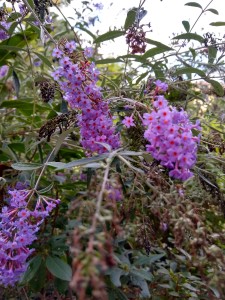 When I am out walking each day, I look at plants—the manicured specimens maintained by landscape crews, the lovingly grown clumps of annuals and perennials on smaller lots, and even the strays—self seeded individuals growing where they may or may not be wanted. The other day I saw a butterfly bush or Buddleia davidii growing out of a large crack in an older building’s masonry foundation. Butterfly bushes tend to be vigorous self seeders, but I have never seen one that insinuated its way into a crack. I am not sure the situation was good for the masonry, but the butterfly bush appeared quite healthy.
When I am out walking each day, I look at plants—the manicured specimens maintained by landscape crews, the lovingly grown clumps of annuals and perennials on smaller lots, and even the strays—self seeded individuals growing where they may or may not be wanted. The other day I saw a butterfly bush or Buddleia davidii growing out of a large crack in an older building’s masonry foundation. Butterfly bushes tend to be vigorous self seeders, but I have never seen one that insinuated its way into a crack. I am not sure the situation was good for the masonry, but the butterfly bush appeared quite healthy.
Butterfly bushes have become ubiquitous in the last half century or so, as interest in flowering shrubs and pollinator gardens has grown. The shrubs’ size, hardiness, fragrance and flower configurations have given rise to the nickname, “summer lilac.” Lilacs and buddleia are not related, but both sport fragrant white, cream, yellow, blue-purple or purple flowers clustered into densely packed spikes. Lilac blooms in spring, while buddleia waits until summer, thereby attracting more butterflies.
As an added bonus, butterfly bushes rebloom regularly throughout the growing season, while traditional lilacs bloom once and depend on only heart-shaped leaves for ongoing beauty.
When butterfly bushes first become popular, the available varieties were rather large, reaching seven feet or more in height, with a spread of up to five feet. With the ongoing trend of smaller gardens and container plantings, breeders have come up with more compact varieties, like ‘Blue Chip Junior’, that grows only 30 inches tall and wide, and ‘Ruby Chip’, with reddish-purple flowers and a similar growth habit. ‘Gold Drop’ is also compact and features the added attraction of golden-green foliage.
Butterfly bushes are native to western China and flourish in sunny spaces with good drainage. If you have clay soil like mine, amend it with lots of organic material.
Like lilacs, unpruned buddleia tend to get very “leggy”, with long branches straining towards the sun and flower clusters appearing only at the ends of those branches. Pruning is also indispensible for tidy appearance and maximum flower production, so don’t be afraid to lop aggressively after each flush of bloom. Cut plants back to about 18 inches tall in late fall, which will give them a head start on the next growing season.
If you are like me and tend to put off necessary pruning, just remember that more pruning equals more butterflies.
I have three butterfly bushes. One flowers in darkest purple and attracts the most butterflies, including twelve monarchs at once on the morning of September 11, 2001. The other pumps out spikes of medium lavender. It is by far the most prolific in both flower and offspring production. I love all things yellow, so it is no surprise that I fell for a hybrid variety, Buddleia x weyeriana ‘Sungold’. The plant sits in a corner of my front garden and the golden yellow flowers shine in late summer into fall. It is the last of the three to flower, but also the last to stop flowering as frost approaches.
If buddleias have a downside, it is their prolific nature. Roger Phillips and Martyn Rix, writing in their wonderful book, The Botanical Garden, note that Buddleia davidii seedlings were among the first plants to colonize bombed-out areas after World War II. In gardens, those same seedlings frequently pop up unbidden. Plants in general and butterfly bushes in particular are no respecters of boundaries, so in many places they have also escaped into the wild. This has led to them being labeled as invasives in some states. Breeders have recognized that fact of buddleia life and many of the newer hybrids and varieties are less troublesome.
If you are like me and have a much loved shrub that is also a rampant self-seeder, keep the ground around it mowed or mulched to nip those tendencies in the bud. Be on the alert for seedlings elsewhere and pull them out promptly. It may be scant comfort, but in my garden, I find that while the lavender butterfly bush has profligate tendencies, the roses of Sharon are much, much worse. In both cases, I try to focus on their beauty while I grub out the offspring.
Many nurseries and garden centers carry buddleia and have stock on hand for the fall planting season. You can also find a good selection for Spring 2023 at Bluestone Perennials, Inc., 7211 Middle Ridge Rd. Madison, OH 44057; 800-852-5243; www.bluestoneperennials.com. Print catalog available.
